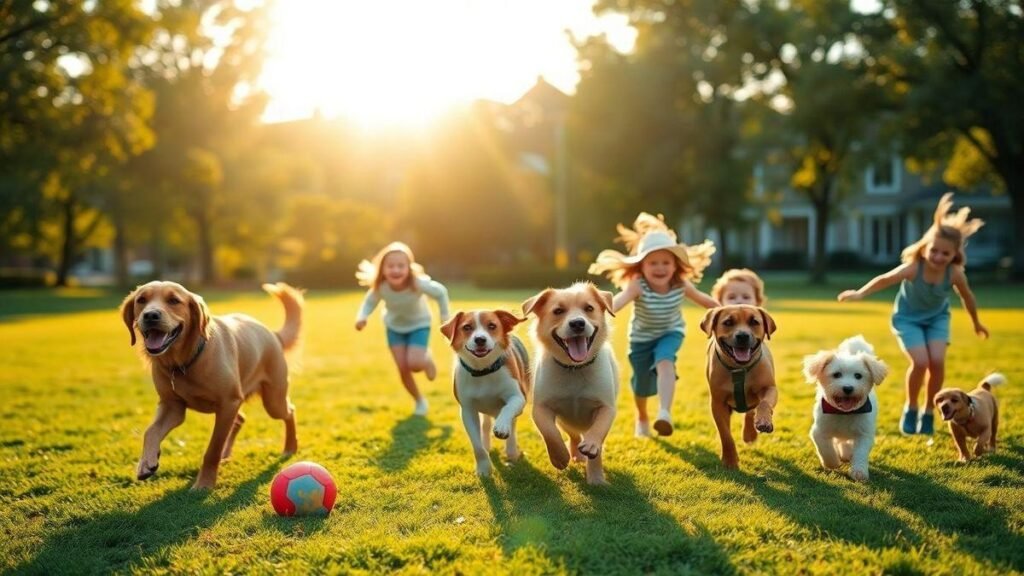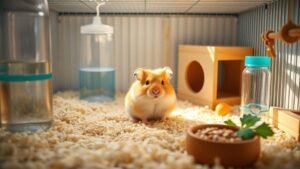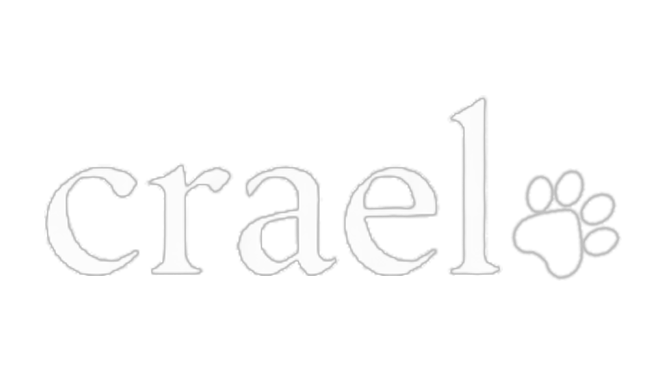Melhores raças de cães para famílias com crianças e comportamento amigável is my practical guide to picking a dog that fits your home. Choosing can feel overwhelming, so I focus on three anchors: temperament, size, and energy. I use breed history, vet advice, and a simple checklist for meeting a new dog. I explain why some small breeds are sturdy and patient, how I teach kids gentle play, and the safety steps I follow. I cover large breeds, space and exercise tips, toddler-friendly picks, low-shedding and allergy-friendly options, grooming and training for first-time owners, and local resources to help you feel confident.

Key takeaway
- I trust Golden Retrievers for being gentle and playful.
- I choose Labrador Retrievers for their patience with kids.
- I find Beagles friendly and great for active families.
- I prefer Cavalier King Charles Spaniels for calm, cuddly love.
- I like Poodles for being smart and low-shedding.
How I choose Melhores raças de cães para famílias com crianças e comportamento amigável
What I look for: temperament, size, and energy
I pick a dog like I pick a friend for my kids: calm, patient, and play-ready. I check:
- Temperament first — a friendly dog is gentle with small hands and loud voices.
- Size next — small dogs can be fragile; large dogs can accidentally knock over toddlers.
- Energy — match the dog’s daily needs to your family’s routine.
| Trait | Why it matters | Example breeds I consider |
|---|---|---|
| Temperament | Keeps kids safe and builds trust | Golden Retriever, Labrador |
| Size | Matches home and child age | Beagle (small/medium), Boxer (medium/large) |
| Energy | Fits family activity level | Cavalier King Charles Spaniel (low-moderate), Border Collie (high) |
Why I trust breed history and vet advice
Breed history shows what a dog was bred to do — people dog, working dog, or quiet companion. I ask my vet about health risks, exercise needs, and socialization tips; I also read up on preventive care like neutering and other health considerations. Real owners’ feedback also helps me avoid mismatches.
A simple checklist I use when meeting a new dog
- Approach slowly. Let the dog come to you.
- Watch body language. Tail wag and relaxed mouth = good sign. Stiff body or tucked tail = caution.
- Offer a hand at chest level. Let the dog sniff first.
- Try a short play test. Gentle tug or fetch shows reactions to kids.
- Ask about history. Owner or shelter staff can share triggers — and shelter staff often follow a standard intake process similar to introductions used when bringing a new pet into a home.
- Check health basics. Clear eyes, clean ears, steady movement; a quick daily touch check helps spot issues.
- Observe patience. See how the dog reacts to sudden noises or quick movements.
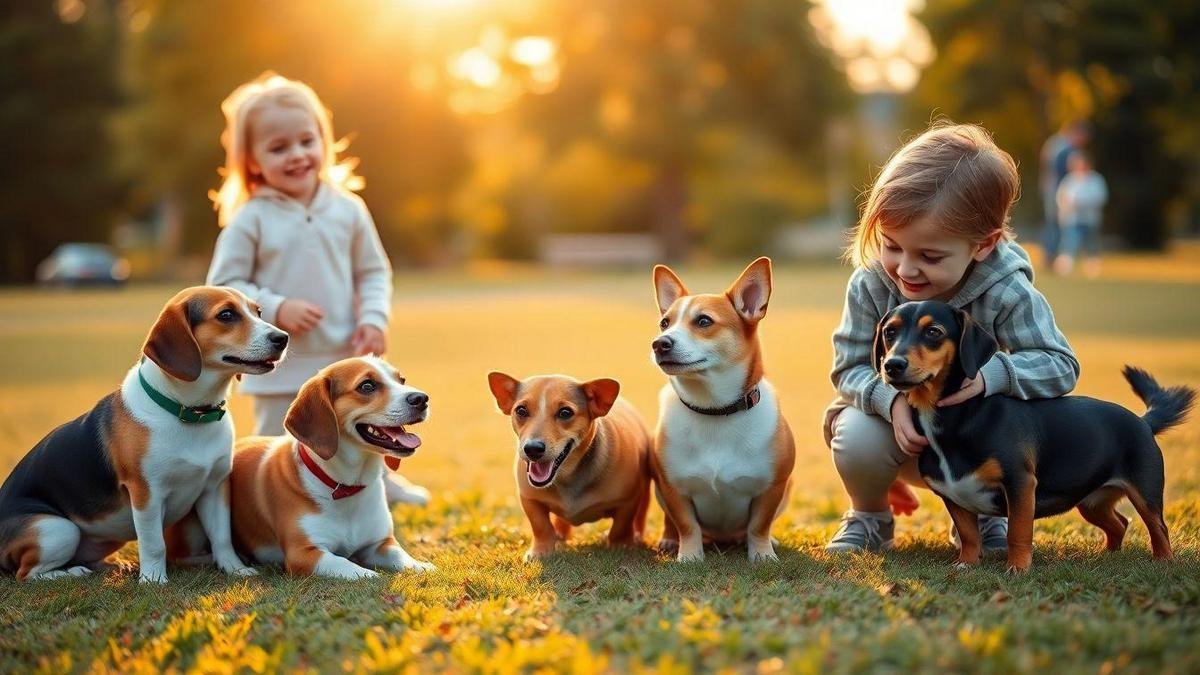
Why I consider small dog breeds good with children
Small dogs often match a child’s energy, sit calmly on a lap, and recover quickly from rough play. When people search “Melhores raças de cães para famílias com crianças e comportamento amigável”, I point to breeds that are patient, sturdy, and easy to read. Small breeds are great for teaching kids how to be gentle.
Small dog breeds good with children that are sturdy and patient
I list breeds I trust and why:
| Breed | Typical size | Why I like them with kids |
|---|---|---|
| Beagle | Small | Playful, curious, tolerant |
| Cavalier King Charles Spaniel | Small | Affectionate, calm, cuddly |
| Bichon Frise | Small | Cheerful, sturdy, low shedding |
| Boston Terrier | Small | Robust, patient |
| Pug | Small | Sociable, forgiving |
| Shih Tzu | Small | Gentle, loyal |
I emphasize temperament over looks. Training, supervision, and clear rules make the biggest difference.
For small breeds that need indoor activity, I rely on short sessions from guides like indoor exercise routines for small dogs to keep energy balanced without exhausting kids.
How I teach kids gentle play
Simple steps kids can follow:
- Model gentle touches — hand flat to show petting.
- Use a soft voice.
- Keep short sessions (10–15 minutes) then rest.
- Reward calm behavior with treats.
- Respect boundaries — no touching while the dog is eating or sleeping.
- Teach a few commands: sit, leave it.
- Supervise until you trust both child and dog.
A little repetition builds habits quickly. I often pair these moments with basic lessons from basic obedience training and short indoor settling drills like teaching your dog to settle on command.
Safety tips around small dogs
- Supervise all interactions with young children.
- No face-to-face hugs; no pulling ears or tails.
- Provide a safe space (crate or bed) for the dog to retreat; see ideas for a comfortable room setup in creating a pet-friendly indoor space.
- Watch for warning signs: growling, stiff body, tucked tail.
- Keep separate toys if possession becomes an issue.
- Keep vaccinations and vet checks up to date.
- Introduce new dogs slowly in a calm area; follow steps like those in introducing a new puppy or kitten to older pets when other animals are present.
| Child Age | Supervision level |
|---|---|
| 0–2 years | Full supervision, arms-length |
| 3–5 years | Close supervision, guide interactions |
| 6–10 years | Active supervision, teach responsibility |
| 11 years | Periodic supervision, build independent care |
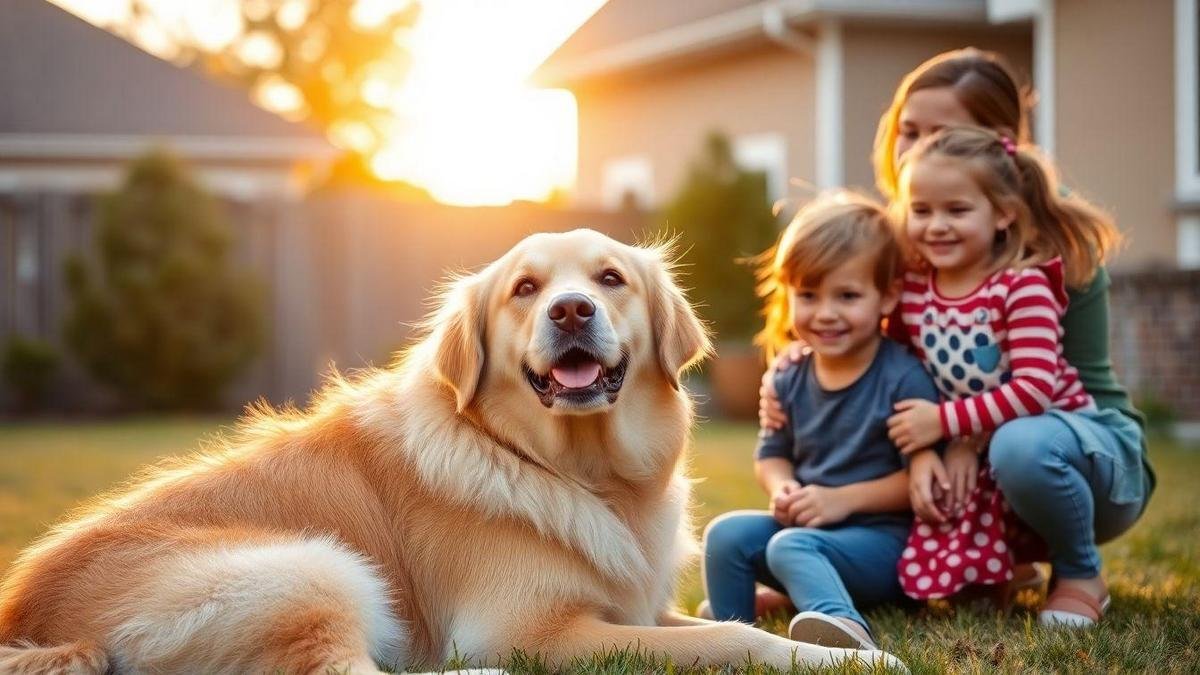
How I assess large dog breeds for family life
I look for steady temperaments, social skills, and trainability. I match the dog to home space and time available. I often search “Melhores raças de cães para famílias com crianças e comportamento amigável” to compare breed traits and family needs.
Large dog breeds good with kids that often show calm and control
| Breed | Why I trust them | What I watch for |
|---|---|---|
| Labrador Retriever | Friendly, eager to please | High puppy energy |
| Golden Retriever | Patient and gentle | Needs regular play |
| Bernese Mountain Dog | Calm, affectionate | Size can knock small kids |
| Newfoundland | Very gentle, nanny-like | Grooming and space needs |
| Standard Poodle | Smart, trainable | Needs mental work |
I meet each dog and watch for soft eyes, relaxed body language, and polite greetings before deciding.
How I manage space and exercise for big family dogs
- Give a dedicated area with bed and toys; tips for laying out a comfortable indoor area are in creating a safe and stimulating indoor space.
- Schedule two walks a day plus a play session; if time is tight, strategies in keeping an indoor dog active on a busy schedule help.
- Add mental exercise (training games, puzzle toys) and consult ideas from signs your dog needs more mental stimulation.
- Use gates for quick separation when needed.
| Space element | My setup |
|---|---|
| Indoor rest | Quiet corner with bed |
| Yard | Fenced area for supervised play |
| Walks | Consistent times |
| Mental work | Short 10–15 minute drills |
Rules for playtime with large dogs:
- Adult supervision always.
- Gentle hands. No pulling ears or tails.
- No rough games (no wrestling/chasing small children).
- Teach kids to sit to greet.
- Use time-outs when the dog gets too excited.
- Use clear commands: sit, stay, off, leave it.
For feeding large breeds I pay attention to nutrition and portioning; see recommendations on foods for large-breed dogs when planning meals.
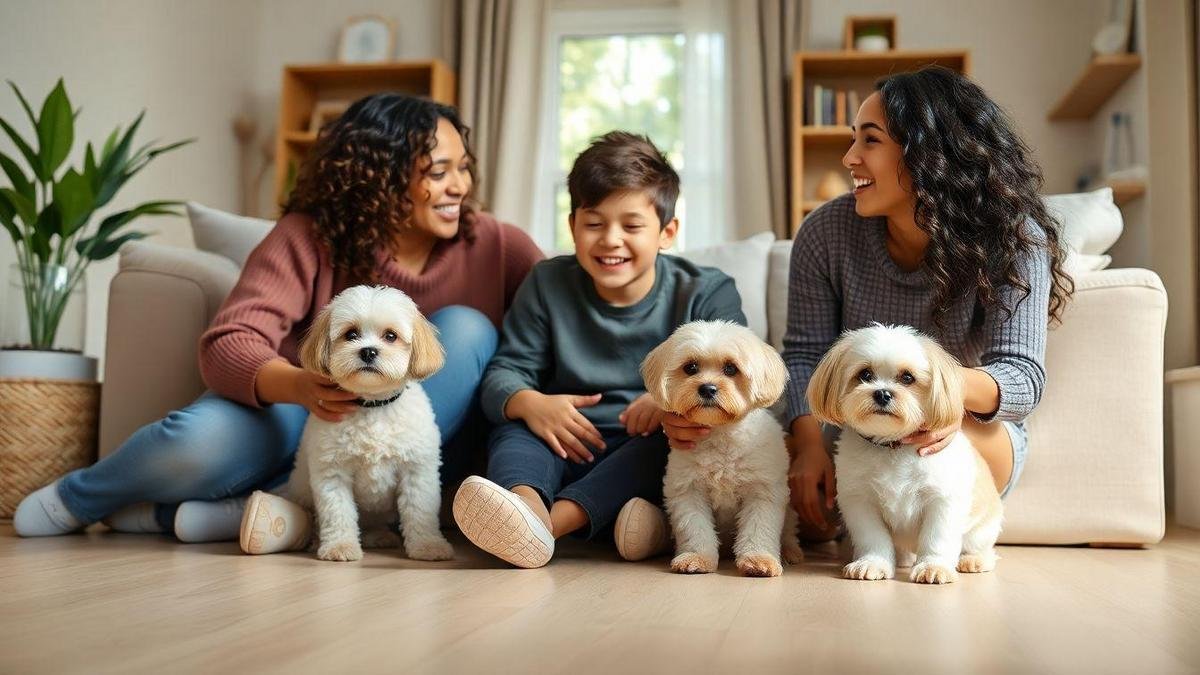
How I find low-shedding, allergy-friendly family dogs
When I research “Melhores raças de cães para famílias com crianças e comportamento amigável”, I focus on breeds that shed less, are gentle with kids, and have calm temperaments. Choosing the right breed helped my family reduce allergy flare-ups.
Melhores raças de cães para famílias com crianças e comportamento amigável that shed less
| Breed | Size | Shedding | Why I chose them for families |
|---|---|---|---|
| Standard Poodle | Medium-Large | Low | Smart, patient, coat sheds little |
| Bichon Frise | Small | Low | Playful, low shedding; coat needs care |
| Portuguese Water Dog | Medium | Low | Energetic, loyal, sheds little |
| Soft-Coated Wheaten Terrier | Medium | Low | Friendly, single coat minimizes loose hair |
| Maltese | Small | Low | Gentle lap dog; best with older kids |
I also consider mixed breeds like doodles, but I always test the coat first.
Grooming and cleaning steps to reduce allergens
- Brush daily or every other day (outside when possible).
- Bathe every 4–6 weeks with a gentle shampoo.
- Trim hair around face and paws every 4–8 weeks.
- Wash bedding and washable toys weekly in hot water.
- Vacuum high-use rooms with a HEPA vacuum twice a week.
- Use an air purifier (HEPA) in the main living area.
Tools and routines I recommend:
- Slicker brush deshedding tool
- Grooming clippers for quick trims
- Vacuum with HEPA filter
- Air purifier (HEPA)
- Washable covers for toys and bedding
| Routine | Frequency | Quick note |
|---|---|---|
| Brush | Daily (5–10 min) | Short sessions prevent mats |
| Vacuum | 2x week | Focus on dog areas |
| Wash bedding | Weekly | Hot water kills allergens |
| Bath | Every 4–6 weeks | Use dog-safe shampoo |
| Pro groom | Every 6–8 weeks | Book around school breaks |
Keeping the home clean and comfortable reduces triggers; see practical steps in keeping your pet environment comfortable and clean and routine care for food and water areas in cleaning food and water areas. For calm focus, I also use scent enrichment techniques from scent enrichment to calm indoor dogs.
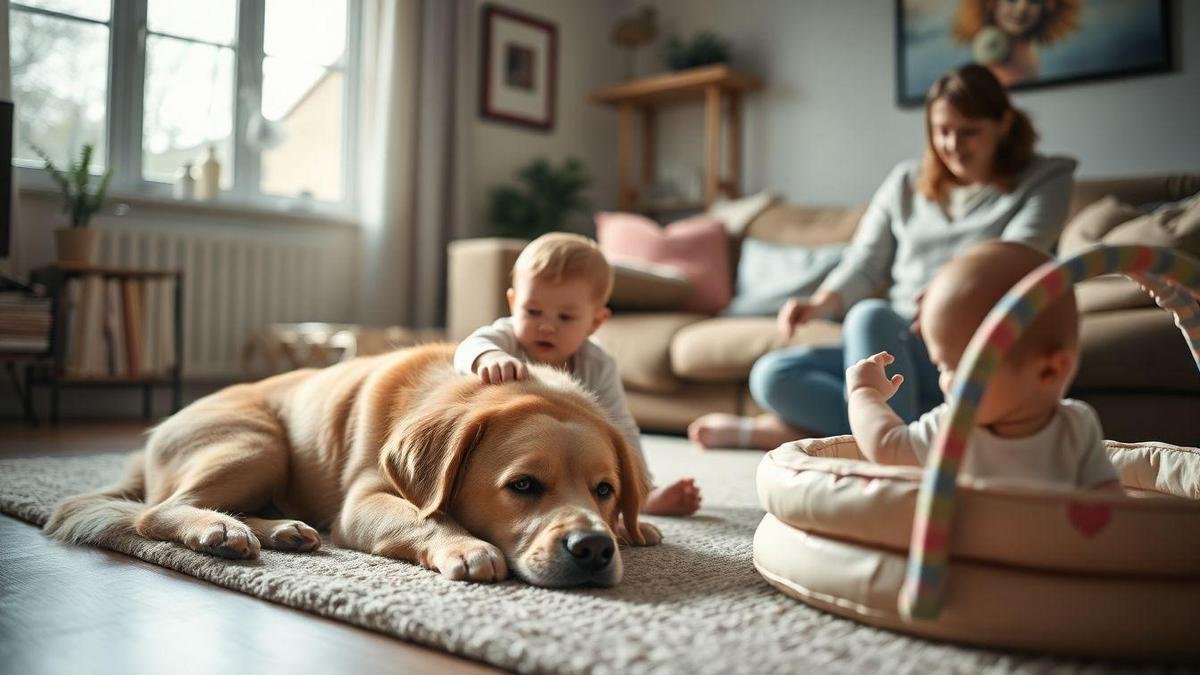
Why calm dog breeds for families matter with toddlers and babies
Calm dogs keep a home safe and peaceful. Toddlers are loud and quick; babies are fragile. A patient, predictable dog lowers the chance of bites or chasing. I use the phrase Melhores raças de cães para famílias com crianças e comportamento amigável as a reminder to pick friendly, steady breeds.
Signs I look for that show a dog is good with kids and babies
| Sign | What it means | Example |
|---|---|---|
| Gentle mouthing | Uses a soft mouth | Takes treats gently |
| High tolerance | Stays calm during noise/hugs | Sits quietly while patted |
| Low prey drive | Doesn’t chase small fast objects | Ignores rolling toys |
| Social friendliness | Approaches calmly | Greets guests without overreacting |
| Trainability | Learns commands quickly | Responds to sit and stay |
I always run short supervised sessions with my child and stop at the first sign of stress.
Best dogs for families with toddlers I recommend
Breeds I often recommend for homes with young kids:
| Breed | Size | Calm level | Why I recommend |
|---|---|---|---|
| Labrador Retriever | Medium-Large | High | Patient, playful |
| Golden Retriever | Medium-Large | High | Gentle, eager to please |
| Beagle | Small-Medium | Moderate | Happy, tolerant |
| Cavalier King Charles Spaniel | Small | High | Affectionate, quiet |
| Basset Hound | Medium | High | Slow-moving, relaxed |
| Pug | Small | Moderate | Playful, gentle |
| Bernese Mountain Dog | Large | High | Gentle giant, affectionate |
I always meet the dog first — breed traits guide me, but each dog is an individual.
Supervision habits I practice around toddlers and dogs
I never leave a toddler and a dog alone. I teach simple rules: touch gently, avoid faces, and leave the dog alone while it eats or sleeps. I use gates or crates when needed and reward calm behavior in both child and dog. When bringing a new animal into a home with children or other pets, I follow steps similar to preparing the home for a new dog or cat and the staged introductions in introducing a new puppy to older pets.
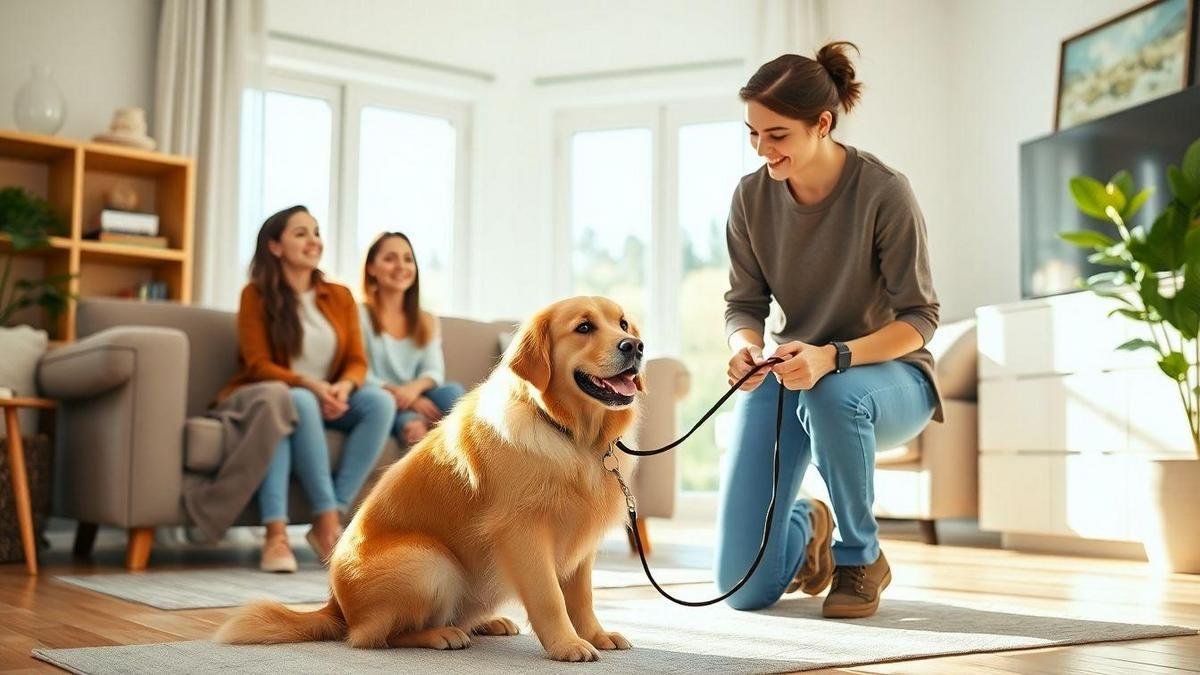
How I guide first-time owners through training and care
I meet new owners where they are: calm and steady. I focus on safety, consistency, and patience. My goal is a dog that is safe, loving, and part of the family.
Training steps I use to make family-friendly dogs safe and loving
| Step | What I teach | Why it matters |
|---|---|---|
| 1. Name & attention | Look at me on cue | Creates focus |
| 2. Sit & wait | Short rewards for self-control | Keeps kids safe during greetings |
| 3. Loose leash walking | Reward relaxed walking | Pleasant outings |
| 4. House rules | Simple rules for furniture/doors | Reduces accidents |
| 5. Gentle socialization | Exposure to people/sounds slowly | Builds confidence |
Keep sessions to 5–10 minutes, repeat often, and praise small wins.
I recommend structured classes and resources like basic obedience for adopted dogs, using mealtime as a training opportunity (mealtime training ideas), and gradual social exposure with tips from socialization in everyday situations.
Melhores raças de cães para famílias com crianças e comportamento amigável for first-time owners
I guide families to breeds that match their routine. The phrase Melhores raças de cães para famílias com crianças e comportamento amigável helps me focus recommendations.
| Breed | Key trait I watch for | Home fit |
|---|---|---|
| Labrador Retriever | Patient and playful | Active families |
| Golden Retriever | Gentle and loyal | Homes with children and routines |
| Beagle | Curious and friendly | Families who will walk daily |
| Cavalier King Charles Spaniel | Affectionate and calm | Small homes, lap lovers |
| Boxer | Energetic and protective | Active kids who like play |
Local resources I point new owners to
- Veterinarian: for wellness checks.
- Puppy classes: short group classes for social skills.
- Obedience clubs: for ongoing training and community.
- Rescue groups: if adopting — they know each dog’s history.
- Online communities: local groups for tips and support.
| Resource | Why I send them there | How I pick them |
|---|---|---|
| Puppy class | Fast social learning | Small groups, positive trainers |
| Vet clinic | Health and vaccine advice | Friendly staff, clear communication |
| Rescue | Honest temperament info | Transparent history and support |
I often join a class with new owners — the shared laugh over a clumsy sit is worth it. For ongoing confidence and a broad set of guides I point new owners to the site’s collection of practical posts at our full resource library.
Conclusion
Choosing a dog is like finding the right piece for your family puzzle. I focus on temperament, size, and energy — the three anchors that make a dog fit daily life. I trust breed history and vet advice, but I always meet the dog and watch real behavior. My checklist keeps me grounded: approach slowly, read body language, test play, and ask about history.
For families, I lean toward breeds that are patient and readable — Golden Retriever, Labrador, Beagle, Cavalier, and smart, low-shedding options like Poodle mixes when allergies matter. Short training bursts, steady supervision, and clear rules turn good dogs into great family members. Small breeds teach gentle handling; big breeds need space and consistent exercise. Consistency wins.
If you want more real-world tips, breed ideas, or step-by-step checklists, explore the full set of posts at our resources. I’ll be here to help you find a dog that fits like a glove.
Frequently asked questions
Which dog breeds are best for families with kids?
I recommend Melhores raças de cães para famílias com crianças e comportamento amigável like Labrador, Golden Retriever, Beagle, Bulldog, and Pug — calm, patient dogs that love play.
Are big dogs safe with small children?
Yes, when the dog is trained and supervised. Watch body language and set clear rules.
What about low-shedding or hypoallergenic breeds?
Consider Poodle mixes, Bichon Frise, or Portuguese Water Dog. Test first, since coats vary, and follow grooming and cleaning routines from keeping the pet environment clean.
How can I choose the right dog for my family?
Meet the dog, check temperament, and match energy to your kids. Pick a dog you can care for daily and prepare your home with tips from preparing your home for a new dog or cat.
How do I teach my kids to behave around dogs?
Teach gentle hands, no shouting, and to leave the dog alone while it eats or sleeps. Stay close and coach with patience; pair those lessons with basic obedience work from obedience training resources.
Note: When searching online, use the keyword Melhores raças de cães para famílias com crianças e comportamento amigável to find breed lists and local resources that match what matters most to your family. For questions about pets living with other species, see advice on dogs and cats living together.

